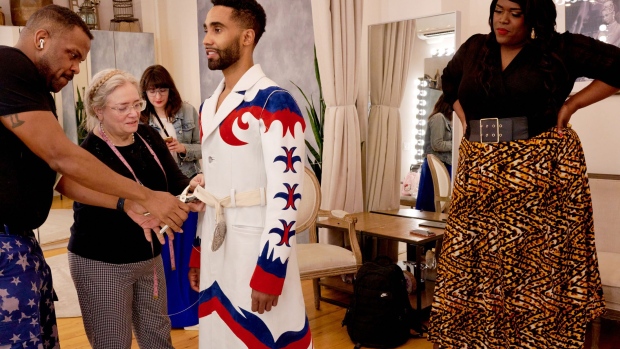Jun 21, 2024
Here’s How the Costumes for a Wild New Production of Cats Got Made
, Bloomberg News

(Bloomberg) -- A few weeks before the premiere of the latest Cats production to arrive in New York, costume designer Qween Jean was busily making final adjustments.
Preternaturally calm, she watched as a team in the midtown costume shop John Kristiansen New York took measurements of actor Jonathan Burke, who was wearing a long, white-leather jacket adorned with red and blue decoration.
Once a few accessories—including a bandana and cowboy hat—were added, Qween Jean asked: “Can we see the breakaway?”
At this point, Burke pulled on what appeared to be a small thread near his armpit. In a movement, the entire sleeve slid off the jacket; with a further pull, the second arm came off. A final pull detached the jacket’s bottom half.
Suddenly, it was a crop top, and Burke was down to a pair of white cowboy boots and Hello Kitty underwear.
CATS: The Jellicle Ball, which opened at Perelman Performing Arts Center (PAC NYC) on June 13 and will run through July 28, is not the Cats musical you grew up with.
For starters, there’s nothing feline about this version, except maybe those Hello Kitty briefs. (The made-up word Jellicle comes from a book of poetry by T.S. Eliot that was the basis for the original Cats musical.)
Instead, the action has been transposed to a queer ballroom where it pits 24 performers against one another in a five-category dance-off set to Andrew Lloyd Webber’s original music.
Co-directed by Zhailon Levingston and Bill Rauch, with choreography by Arturo Lyons and Omari Wiles, the production is a sartorial marathon. With five separate competitive categories, outfit changes come fast and furiously. “We were able to produce 300 costumes for the show,” Qween Jean recalls in a subsequent interview.
Proof of Concept
Qween Jean was first approached to do the costumes about two years ago. Her initial reaction, she says, was: “Are we doing catsuits?”
Over time, Qween Jean continues, the question as she attended various workshops became: “How do we tell this story that’s a classic but center it on the legacy of ballroom?” The characters in the musical are “mostly about people who’ve been marginalized, and my work is deeply rooted in advocacy and collective liberation,” she says. “To me, Cats upholds so many of those themes.”
Ballroom culture broke into mainstream consciousness with the nearly simultaneous releases of Madonna’s Vogue and the 1990 documentary Paris is Burning. Its origins date back to at least the 1920s, though. Pioneered by Black and Latinx LGBTQ people in Harlem, such balls served as safe spaces for marginalized communities as well as places for extraordinary innovation and creativity, she says. “We’re infusing so many great ideas about the past, present, and also moving the body forward.”
Qween Jean has designed costumes for the Shakespeare Theatre Company, the TV show Empire and the Santa Fe Opera, among others, but this version of Cats wasn’t a simple process of designing costumes for an existing production.
The designer set about creating costumes that would not only evoke ballroom culture but also function as dynamic, durable, eye-catching outfits that could be worn—and danced in—night after night.
Most important, the choreography—which often entails surprise reveals such as Burke’s jacket—relies on the costumes.
“So many of the costumes have a surprise reveal built into them that folks’ mouths will drop,” Qween Jean says. “So there’s been deep conversations around how each moment has been built, and what the choreographer is dreaming up and how the clothes are in deep alignment with it.”
Making it Work
Qween Jean began with sketches. In addition to the 300 that became costumes, she estimates that 500 were left on the drawing board. Working with a large team—“There’s no way I could do it by myself,” she says; “I’m a super woman, but we’d be here for another two years”—she then chose fabrics, a process she estimates took four months.
A large team took about two months creating the clothing and accessories, and then it was time to see how the costumes worked in practice
The goal in choosing materials, Qween Jean explains, was to make the costumes look truly original as if “these individuals have truly customized their outfits and found a way to shine tonight,” she says. “To me, NYC ballroom has unlimited creativity, and that’s the center of this work.”
Most pieces are machine washable, she says. “People are dancing and perspiring.”
As Qween Jean tweaked and refined every look, the costumes remained personal. “When I moved to New York, I didn’t have any money or many things, but the dream of New York City is that you can build your armor,” she says. “You want to step out into something you feel empowered and beautiful in—something that tells people who you are, instead of people trying to place you where you don’t belong.”
©2024 Bloomberg L.P.


